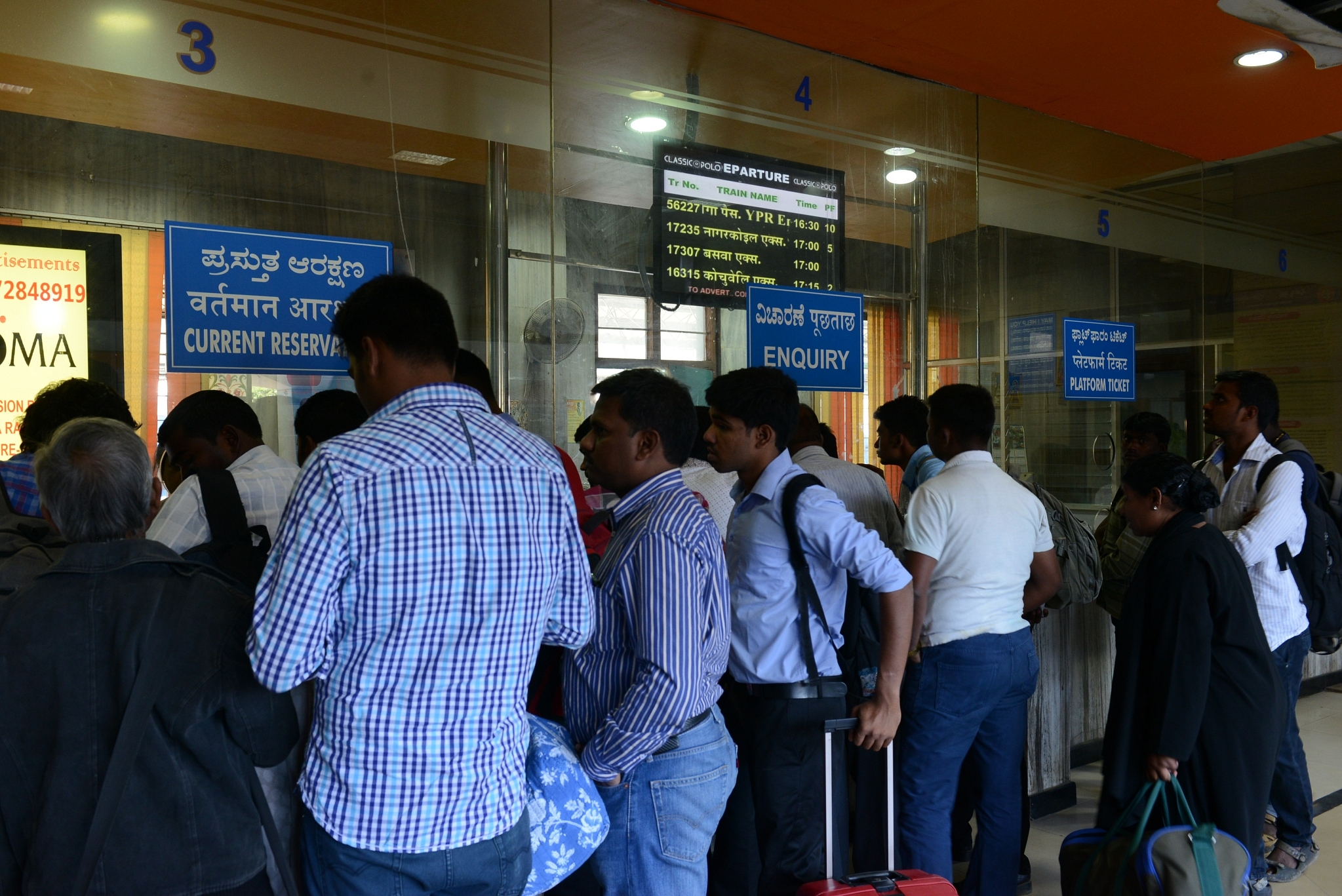News Brief
On The Anvil: Railways To Offer Confirmed Berths To All Passengers, Increase Its Share Of Freight Loading At Reduced Costs
- All this and more is envisaged in the National Rail Plan 2030.

Users queing up to buy tickets at Krantivira Sangoli Rayanna Railway Station in Bengaluru (Hemant Mishra/Mint via Getty Images)
That all passengers will get confirmed tickets with a provision for adequate number of trains, while significantly increasing goods loading, are being envisaged in the National Rail Plan-2030.
In an endeavour to address the inadequacies of capacity constraints and improve its modal share in the total freight ecosystem of the country, Indian Railways has come up with the draft of the National Rail Plan (NRP).
Indian Railways is hoping to increase its share in freight transportation from the present 27 per cent to 45 per cent by 2030 through better infrastructure and business development plans, Railway Board Chairman VK Yadav said in a presser in New Delhi recently.
Railways transported only 1,210 MT of the total freight basket of 4,700 MT till the end of 2019, but by 2024, it is planning to load 2,024 MT of the estimated 6,400 MT of total freight, keeping it on track to achieve its target by 2030.
Yadav said under Vision 2024 of the National Rail Plan, the railways plans to augment its infrastructure to enable the loading of 2,024 MT by 2024, multi-tracking of a 16,373-km network, completion of 58 super critical projects, 68 critical projects, 46 projects on HDN (high-density network) and HUN (highly-utilised network) and 32 other essential projects.
"The final draft of the National Rail Plan is ready and it will be circulated among the stakeholders for their views. In a month's time, we should be able to finalise it. Under the plan, we aim to raise our share of freight loading from the current 27 per cent to 45 per cent by 2030," he said.
The Railway Board chairman said the national transporter will complete 20 additional coal connectivity projects and by December 2023, conclude 146 railway electrification projects.
It will also complete northeast connectivity projects of 288 km by March 2023 and the balance of 111 km of the Udhampur-Srinagar-Baramulla project by December 2022.
The Vision 2024 plans will also include the speed raising of the New Delhi-Howrah and New Delhi-Mumbai routes to 160 kmph and that of the Golden Quadrilateral (GQ) and Golden Diagonals (GD) routes to 130 kmph.
All these projects will include a total capital expenditure of Rs 2.9 lakh crore, Yadav said.
"Vision 2024 is a subset of the National Rail Plan. We are doing GIS mapping of the entire network and taking into account future industries that will be coming up, planning on what commodities would require transportation. The aim is to reduce the transit time as well as the transit cost for our customers. We are planning to rationalise the freight tariff and slowly reduce the haulage charges, so that we can reduce cost and increase revenue," he said.
The total capital expenditure for capacity enhancement has been estimated to be Rs 2.9 lakh crore in 2024.
The National Rail Plan includes three dedicated freight corridors with a total length of 3,958 km — the 1,115-km East Coast DFC from Kharagpur to Vijayawada, the 1,868-km East-West DFC (Bhusawal-Nagpur-Kharagpur-Rajkharsawan-Andal-Dankuni) and the 975-km North-South DFC (Itarsi-Nagpur-Vijayawada).
According to railways, the plan is to reduce transit time of freight substantially by increasing the average speed of freight trains from the present 22 kmph to 50 kmph.
It also entails a plan to reduce the overall cost of rail transportation by nearly 30 per cent and pass on the benefits to customers.
Yadav said as part of the plan, several new high-speed rail corridors have been identified and a survey on the Delhi-Varanasi High Speed Rail is underway.
The plan also includes bringing in modern rolling stock, identifying new streams of finance and models for financing, including those based on PPP, he said.
"For the successful implementation of the NRP, the railways will engage with the private sector, PSUs, state governments, original equipment manufacturers (OEMs)/industries etc.," Yadav said.
A long term strategic plan called the National Rail Plan has been developed to plan infrastructural capacity enhancement along with strategies to increase modal share of the Railways.
The National Rail Plan will be a common platform for all future infrastructural, business and financial planning of the Railways.
This plan is being circulated among various ministries for their views now. Railways aims to finalise the final plan by January 2021.
Support Swarajya's 50 Ground Reports Project & Sponsor A Story
Every general election Swarajya does a 50 ground reports project.
Aimed only at serious readers and those who appreciate the nuances of political undercurrents, the project provides a sense of India's electoral landscape. As you know, these reports are produced after considerable investment of travel, time and effort on the ground.
This time too we've kicked off the project in style and have covered over 30 constituencies already. If you're someone who appreciates such work and have enjoyed our coverage please consider sponsoring a ground report for just Rs 2999 to Rs 19,999 - it goes a long way in helping us produce more quality reportage.
You can also back this project by becoming a subscriber for as little as Rs 999 - so do click on this links and choose a plan that suits you and back us.
Click below to contribute.
Latest